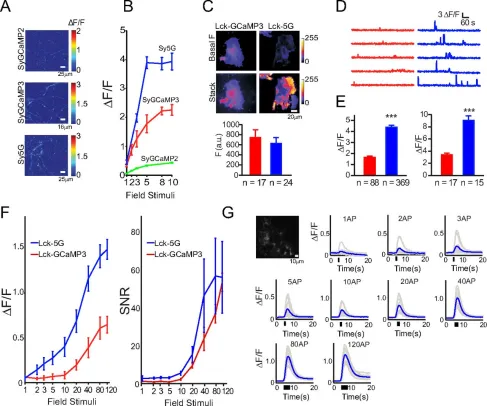A few papers on in vivo calcium imaging have just come out and are worth a careful read.
The first two examine the fine organization of layer 2/3 of the mouse auditory cortex. The canonical view of auditory cortex organization is that neurons are arranged in a tonotopic pattern, with a smooth gradient in auditory frequency tuning across the surface of the cortex. Using two-photon imaging in anesthetized mice, the groups saw that, while there was an overall gradient, the tuning of neighboring neurons was highly variable. These are similar results to what Sato et al and Kerr et al found in the whisker barrel cortex back in 2007. Moral of the story : mapping brain organization by microstimulation or sparse sampling (as in the classic papers) can be very misleading.
UPDATE : David Kleinfeld kindly directed me to the 40 year old work by Moshe Abeles and others that showed a similar spread in frequency tuning using microelectrodes…


Now, back to the more recent papers…
Functional organization and population dynamics in the mouse primary auditory cortex – Rothschild G, Nelken I, Mizrahi A. Nat Neurosci. 2010 Mar;13(3):353-60. Epub 2010 Jan 31.
Cortical processing of auditory stimuli involves large populations of neurons with distinct individual response profiles. However, the functional organization and dynamics of local populations in the auditory cortex have remained largely unknown. Using in vivo two-photon calcium imaging, we examined the response profiles and network dynamics of layer 2/3 neurons in the primary auditory cortex (A1) of mice in response to pure tones. We found that local populations in A1 were highly heterogeneous in the large-scale tonotopic organization. Despite the spatial heterogeneity, the tendency of neurons to respond together (measured as noise correlation) was high on average. This functional organization and high levels of noise correlations are consistent with the existence of partially overlapping cortical subnetworks. Our findings may account for apparent discrepancies between ordered large-scale organization and local heterogeneity.

In vivo two-photon calcium imaging from dozens of neurons simultaneously in A1.
Dichotomy of functional organization in the mouse auditory cortex – Bandyopadhyay S, Shamma SA, Kanold PO. Nat Neurosci. 2010 Mar;13(3):361-8. Epub 2010 Jan 31.
The sensory areas of the cerebral cortex possess multiple topographic representations of sensory dimensions. The gradient of frequency selectivity (tonotopy) is the dominant organizational feature in the primary auditory cortex, whereas other feature-based organizations are less well established. We probed the topographic organization of the mouse auditory cortex at the single-cell level using in vivo two-photon Ca(2+) imaging. Tonotopy was present on a large scale but was fractured on a fine scale. Intensity tuning, which is important in level-invariant representation, was observed in individual cells, but was not topographically organized. The presence or near absence of putative subthreshold responses revealed a dichotomy in topographic organization. Inclusion of subthreshold responses revealed a topographic clustering of neurons with similar response properties, whereas such clustering was absent in supra-threshold responses. This dichotomy indicates that groups of nearby neurons with locally shared inputs can perform independent parallel computations in the auditory cortex.

Tonotopy exists in A1 and AAF on a large scale, but not on small spatial scales.
The third paper uses a GECI (YC3.6) to do chronic imaging in visual cortex. Their results are noteworthy in that they look at visual responses to both a passive viewing and an ACTIVE discrimination task in an awake, head-fixed mouse. The patterns of neural activity between anesthetized, awake but passively receiving sensory input, and awake while paying attention and using the sensory input are likely to be hugely different. Recording from neurons that are actively involved in a discrimination task is essential to understanding how the cortex is actually processing information. Although this paper is more focused on simply presenting the technique rather than in depth analysis of the activity, we will be seeing more of this style of neuroscience in high-profile journals very soon…
Chronic cellular imaging of mouse visual cortex during operant behavior and passive viewing – Andermann ML, Kerlin AM and Reid RC, Front. Cell. Neurosci. 4:3.
Nearby neurons in mammalian neocortex demonstrate a great diversity of cell types and connectivity patterns. The importance of this diversity for computation is not understood. While extracellular recording studies in visual cortex have provided a particularly rich description of behavioral modulation of neural activity, new methods are needed to dissect the contribution of specific circuit elements in guiding visual perception. Here, we describe a method for three-dimensional cellular imaging of neural activity in the awake mouse visual cortex during active discrimination and passive viewing of visual stimuli. Head-fixed mice demonstrated robust discrimination for many hundred trials per day after initial task acquisition. To record from multiple neurons during operant behavior with single-trial resolution and minimal artifacts, we built a sensitive microscope for two-photon calcium imaging, capable of rapid tracking of neurons in three dimensions. We demonstrate stable recordings of cellular calcium activity during discrimination behavior across hours, days, and weeks, using both synthetic and genetically-encoded calcium indicators. When combined with molecular and genetic technologies in mice (e.g., cell-type specific transgenic labeling), this approach allows the identification of neuronal classes in vivo. Physiological measurements from distinct classes of neighboring neurons will enrich our understanding of the coordinated roles of diverse elements of cortical microcircuits in guiding sensory perception and perceptual learning. Further, our method provides a high-throughput, chronic in vivo assay of behavioral influences on cellular activity that is applicable to a wide range of mouse models of neurologic disease.

Mapping visual responses in identified excitatory and inhibitory neurons in awake mice







Recent Comments